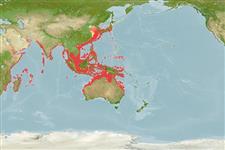Classificação / Names
Common names from other countries
Referência principal
Tamanho / Peso / Idade
Max length : 145 cm FL macho/indeterminado; (Ref. 40637); common length : 70.0 cm FL macho/indeterminado; (Ref. 168); Peso máx. publicado: 35.9 kg (Ref. 168)
Ambiente
; marinhas; oceanódromo (Ref. 51243); intervalo de profundidade 10 - ? m
Clima / Intervalo
Tropical, preferred 28°C (Ref. 107945); 47°N - 31°S, 34°E - 154°E (Ref. 54923)
Distribuição
Descrição breve
Vértebras: 39. A small species, deepest near the middle of the first dorsal fin base. The second dorsal fin is higher than the first dorsal fin; the pectoral fins are short to moderately long; swim bladder is absent or rudimentary. Lower sides and belly silvery white with colorless elongate oval spots arranged in horizontally oriented rows. The dorsal, pectoral and pelvic fins are blackish; the tip of the second dorsal and anal fins are washed with yellow; the anal fin is silvery; the dorsal and anal finlets are yellow with grayish margins; the caudal fin is blackish, with streaks of yellow green.
Categoria na Lista Vermelha da IUCN (Ref. 115185)
Ameaça para o homem
Harmless
Utilização humana
Pescarias: altamente comercial; peixe desportivo: sim
Ferramentas
Relatórios especiais
Descarregue XML
Fontes da internet
Estimates of some properties based on models
Phylogenetic diversity index
PD50 = 0.5039 many relatives (e.g. carps) 0.5 - 2.0 few relatives (e.g. lungfishes)
Nível Trófico
4.5 ±0.6 se; Based on diet studies.
Resiliência
Médio, tempo mínimo de duplicação da população 1,4 - 4,4 anos (K=0.32; assuming tm=2-4)
Vulnerabilidade
Moderate to high vulnerability (47 of 100)
Categoria de preço
